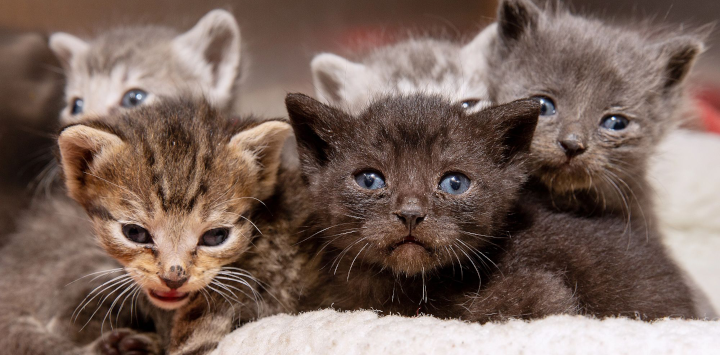
Managing feline disease outbreaks
February 7th, 2023
Last week Best Friends medical director Erin Katribe, DVM, talked about how shelters can keep their dogs healthy by preventing and managing some of the more prevalent diseases. This week, we discussed how to do the same for feline populations.
We know that ringworm is a common issue afflicting cats in shelters, and you previously talked about ways to handle that. What other issues are having a negative impact on feline health?
In addition to ringworm, the most common infectious diseases of concern in shelters are feline panleukopenia and feline upper respiratory tract disease, also commonly referred to as feline upper respiratory infection (URI).
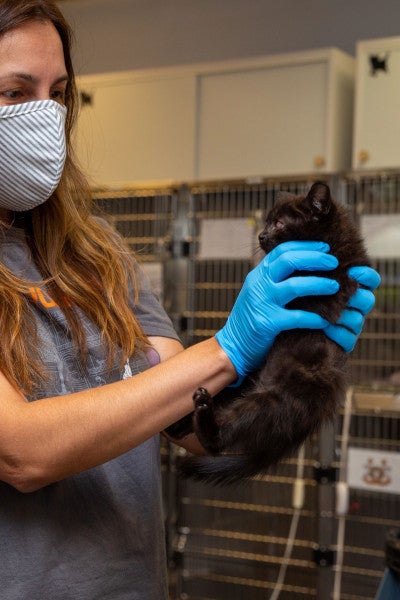 The virus that causes panleukopenia is actually closely related to canine parvovirus, and it causes illness similar to that seen in dogs. The most common clinical signs are vomiting, diarrhea, weight loss, a decreased appetite, and dehydration. In some cases, disease progression is really rapid, and so the only “symptom” we see is sudden death. In fact, panleukopenia is the number one cause of sudden death in shelter cats, meaning that any unexpected death, especially in a kitten, should be considered due to panleukopenia until proven otherwise via necropsy.
The virus that causes panleukopenia is actually closely related to canine parvovirus, and it causes illness similar to that seen in dogs. The most common clinical signs are vomiting, diarrhea, weight loss, a decreased appetite, and dehydration. In some cases, disease progression is really rapid, and so the only “symptom” we see is sudden death. In fact, panleukopenia is the number one cause of sudden death in shelter cats, meaning that any unexpected death, especially in a kitten, should be considered due to panleukopenia until proven otherwise via necropsy.
URIs in shelter cats are primarily viral in origin, with calicivirus and herpesvirus being the two primary offenders. Other viruses and bacteria can play a role, as well, either as primary causes or as secondary pathogens that cause disease once those primary viral pathogens establish an infection. The classic signs we see are eye discharge, conjunctivitis, nasal discharge, sneezing, and sometimes oral and facial ulcers. Calicivirus can also cause a limping syndrome, especially in kittens.
Of course, managing the population in terms of intake numbers and housing capacity is the first line of defense with these issues, just as it is with canine diseases, correct?
That is absolutely correct. Just as in dogs, the primary risk factors in development of disease are stress, overcrowding, and length of stay in the shelter. Unlike the more serious canine pathogens, the viruses that cause feline URI are very common in feline populations and can be found even in healthy cats. Particularly for feline URI in shelters, disease prevention measures to prevent physical spread are still important. However, these husbandry and population-level risk factors should really take priority as we will never be able to completely eliminate these pathogens in our cats.
For other diseases like ringworm and panleukopenia, which we do not find in healthy cats, keeping the pathogen out of the population is crucial. Those same risk factors matter, though, because of the impacts of stress when cats are densely housed or don’t have enough space, and because of the increased likelihood of incomplete sanitation and biosecurity when staff are overwhelmed.
Next up in terms of prevention is vaccination upon intake. Can you touch on the impact of vaccines for each of these illnesses?
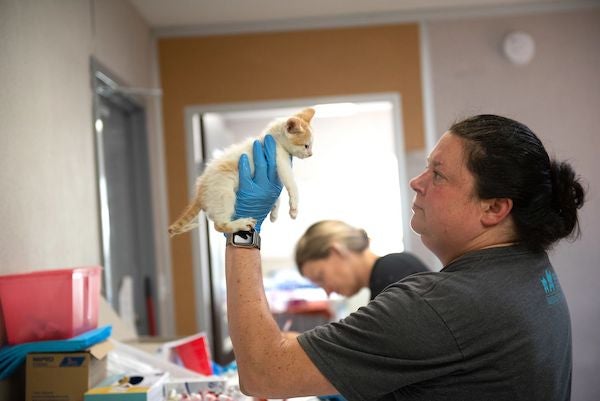 The FVRCP vaccine is considered core for cats, and we recommend that it be given immediately upon intake (or prior to intake) for all shelter cats and kittens. This combination vaccine will provide protection from both panleukopenia and against our two main viral upper respiratory pathogens. For panleukopenia, once the vaccine has had a chance to take effect and if the cat’s immune system responds to it, we achieve essentially full protection from the disease.
The FVRCP vaccine is considered core for cats, and we recommend that it be given immediately upon intake (or prior to intake) for all shelter cats and kittens. This combination vaccine will provide protection from both panleukopenia and against our two main viral upper respiratory pathogens. For panleukopenia, once the vaccine has had a chance to take effect and if the cat’s immune system responds to it, we achieve essentially full protection from the disease.
For calicivirus and herpesvirus, however, even after the vaccine series is completed and we’re not dealing with kittens who may not respond to early vaccination, we do not get complete protection. The vaccine can reduce the severity of disease and reduce shedding of the pathogen, but cats can still become infected and can still become sick. However, decreases in severity, duration, and shedding make this vaccine absolutely recommended for cats in shelters, as these reductions will decrease the time in shelter for the individual cat and will decrease the risk of transmission to other cats.
Unfortunately, there is no vaccine available for ringworm. If someone could develop that successfully, though, all of us in shelter medicine would be ecstatic!
Again, so as not to repeat the info we shared last week, proper cleaning, disinfection and handling should be covered by standard operating procedures at any shelter. One thing I have seen at many shelters – especially when they use day program staff for cleaning, or a revolving group of volunteers – is the habit of removing cats from the cages to clean. In the worst instances, I visited a shelter where standard practice was just NOT to clean for days on end (even the litter boxes), and another where they routinely placed cats in transfer cages and then set them on the floor while the cage was being cleaned. Obviously, these are hardly the best methods for managing cats.
Because of the huge role that stresses plays in feline disease in shelters, we really have to closely examine our procedures and critically evaluate what’s actually necessary. For cats who are going to remain in the same kennel for several days, spot-cleaning while the cat remains in their kennel will reduce their stress. The use of double-compartment housing or feral/small mammal dens can facilitate this process.
Movement, including moves to temporary housing while cleaning, has been shown to increase the risk of upper respiratory disease in shelter cats. Adequately sized housing can also reduce the incidence of URI. Double-compartment housing also carries the added benefit of better safety for shelter staff.
It’s worth further mentioning the role of humane housing on feline illness in shelters, and the Association of Shelter Veterinarians recently released updated standards in this area. Again, because the diseases we worry about the most are exacerbated by stress, housing and husbandry are even more important for cats. Things to pay attention to include allowing cats enough space to move around, providing hiding places in their kennels, providing an elevated resting surface, providing soft bedding, separating their food and water dishes from their litterbox, keeping cats separate from dogs (both auditorily and visually), and providing opportunities for them to express normal feline behaviors like scratching and perching.
Can you talk more about the role of stress in disease for cats. We didn’t touch on that with dogs, and I know it’s relevant for all species. Aren’t cats even more susceptible to the negative impacts of stress? Or is that a myth?
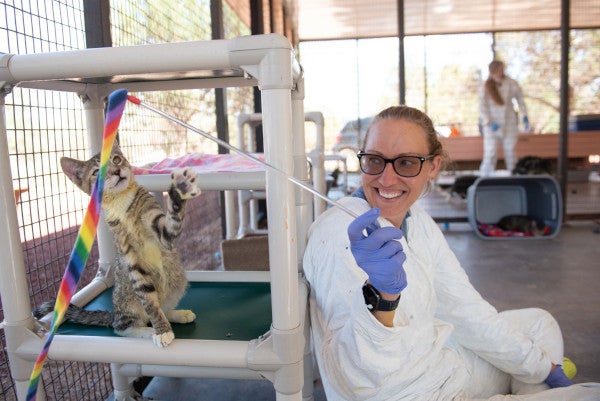 The shelter is an inherently stressful place for all pets, regardless of species, but I think the challenge with cats seems to be worse. Stress causes decreased immune system function in all species, but because of the dramatic effect that stress has on the incidence of URI in shelter cats, it is worth extra attention and resource investment. This means really focusing on humane, adequately sized housing, enrichment, and reducing cats’ length of stay in the shelter. Anything we can do to move them through the system faster (or not have them in the system at all, as with community cat programs) will have such a huge impact – both for individual cats and for the shelter’s overall lifesaving capacity.
The shelter is an inherently stressful place for all pets, regardless of species, but I think the challenge with cats seems to be worse. Stress causes decreased immune system function in all species, but because of the dramatic effect that stress has on the incidence of URI in shelter cats, it is worth extra attention and resource investment. This means really focusing on humane, adequately sized housing, enrichment, and reducing cats’ length of stay in the shelter. Anything we can do to move them through the system faster (or not have them in the system at all, as with community cat programs) will have such a huge impact – both for individual cats and for the shelter’s overall lifesaving capacity.
To compound matters, my experience has been that many shelter staff are not as well-versed in identifying signs of stress in cats, as they can be more subtle than in dogs. It’s crucial to educate staff about what stress looks like in our shelter pets so we can identify those animals and take extra steps to get them out of that environment as quickly as possible. That would be through such programs and policies like prioritizing return-to-field/return-to-home, establishing a network of foster homes, highlighting animals for adoption on all social media, waiving adoption fees, or even just a simple move to a quieter space if one is available.
Shelters that haven’t looked into Fear Free training should do so, as it offers free online and in-person education to veterinary professionals, the pet professional community, and pet owners.
Will you run through each of the most common – and feared – cat diseases in terms of treating them, including (of course) the role of supportive care?
Because feline panleukopenia, like canine parvo, is caused by a virus, there’s no direct treatment and we have to focus on intensive supportive care while the virus runs its course. This means medications to help with gastrointestinal signs, fluids to rehydrate cats as dehydration can be life-threatening, early nutrition (orally or sometimes through feeding tubes), and antibiotics to protect from secondary infections that can also be life-threatening.
URIs are typically viral in origin, too, and so for more mild cases without an obvious bacterial component, we also just treat supportively. Things like nebulization, fluids for hydration and to address fevers, and pain medication for oral ulceration all play a role. For cats where there is a bacterial component, antibiotics are indicated with doxycycline being the recommended first-line choice for shelter URI.
All treatments must be administered under the supervision of a veterinarian, and I strongly encourage shelters to work with vets with shelter experience to design protocols so that uncomplicated cases can be started on treatment rapidly without necessarily needing to directly involve a vet on every individual case. Rapid care improves welfare for the individual cats and also reduces their time in the shelter’s care. That, in turn, will increase the shelter’s lifesaving capacity.
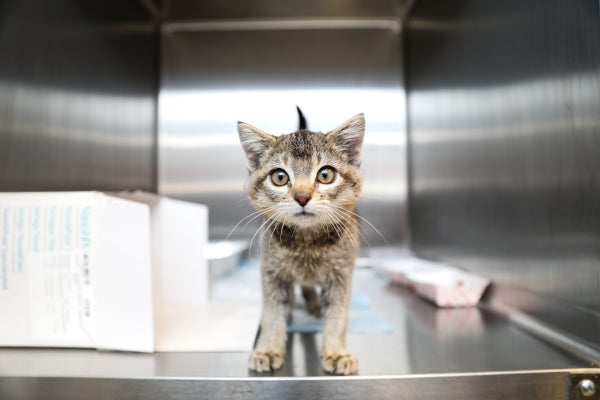
Finally, can you give us your key takeaways for shelters facing outbreaks of feline diseases, just as you did for our canine disease overview?
While feline outbreaks do happen, in many cases when I’m asked to consult with shelters, I find they are not experiencing an outbreak in the traditional sense. Instead, it’s the coalescing of multiple factors that contribute to increased disease in shelter cats (e.g., stress, inadequate housing, long shelter stays, overcrowding). There may be a true outbreak component, like panleukopenia on top of these other factors, but often that hasn’t even been identified because shelters aren’t aware of it as a cause of sudden death in shelter cats. If your shelter is experiencing more feline disease or even deaths, reach out for help from a shelter medicine expert, as we can help you to sort through what’s actually going on.
The next takeaway for me when we're looking at infectious disease in our feline populations is that our focus should be on getting those cats out of the shelter as quickly as possible. For those who do have to stay, we should invest resources into adequate and humane housing. The role of sanitation and biosecurity is certainly important, too, but even those areas become easier to address for our staff when housing for cats is appropriate.
This is especially the case for shelters that are seeing a lot of disease in their feline population. Whether that’s respiratory disease or panleukopenia, such shelters need to be taking a critical look at population management and husbandry, as these will be their primary strategies to reduce feline disease.

Liz Finch
Senior Writer
Best Friends Network
If you enjoyed this editorial, you can find our complete catalog here.